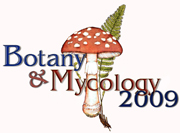The very Best thing
about
Botany Conferences are the People!
Botany
without Borders
Dr. Karl Niklas' Presidential address and gift to
all botanical/plant societies is now online. Click
on the image below to view the multi-media event. Free
copies are also available as a teaching/educational
resource. Follow the ordering instructions on the viewing
page.

The Program from Botany 2008
Search Botany 2008 Abstracts

July 25-29, 2009
- Snowbird, Utah
Mycological Society of
America
American Fern Society
American Bryological and Lichenological Society
American Society of Plant Taxonomists
and the Botanical Society of America
Go to Botany/Mycology
2009 to Submit to be part of
the Program
|